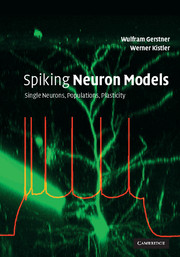Book contents
9 - Spatially structured networks
Published online by Cambridge University Press: 05 June 2012
Summary
So far the discussion of network behavior in Chapters 6–8 has been restricted to homogeneous populations of neurons. In this chapter we turn to networks that have a spatial structure. In doing so we emphasize two characteristic features of the cerebral cortex, namely the high density of neurons and its virtually two-dimensional architecture.
Each cubic millimeter of cortical tissue contains about 105 neurons. This impressive number suggests that a description of neuronal dynamics in terms of an averaged population activity is more appropriate than a description at the single-neuron level. Furthermore, the cerebral cortex is huge. More precisely, the unfolded cerebral cortex of humans covers a surface of 2200–2400 cm2, but its thickness amounts on average to only 2.5–3.0 mm2. If we do not look too closely, the cerebral cortex can hence be treated as a continuous two-dimensional sheet of neurons. Neurons will no longer be labeled by discrete indices but by continuous variables that give their spatial position on the sheet. The coupling of two neurons i and j is replaced by the average coupling strength between neurons at position x and those at position y, or, even more radically simplified, by the average coupling strength of two neurons being separated by the distance |x − y|. Similar to the notion of an average coupling strength, we will also introduce the average activity of neurons located at position x and describe the dynamics of the network in terms of these averaged quantities only.
- Type
- Chapter
- Information
- Spiking Neuron ModelsSingle Neurons, Populations, Plasticity, pp. 315 - 348Publisher: Cambridge University PressPrint publication year: 2002



